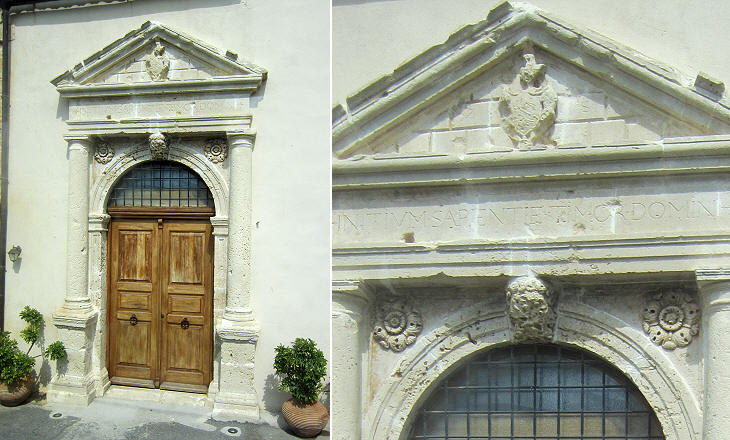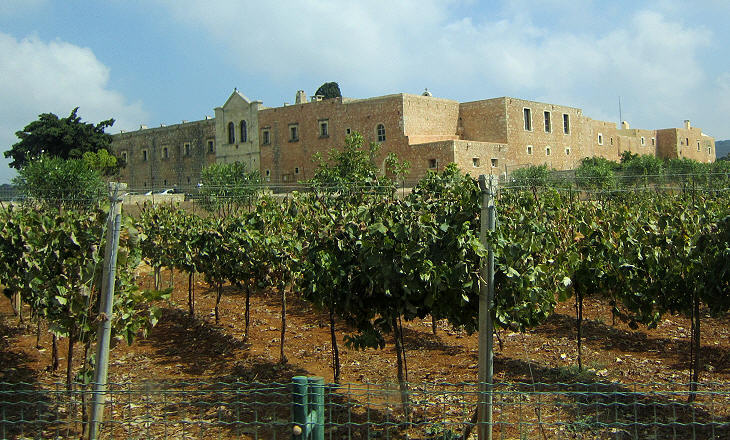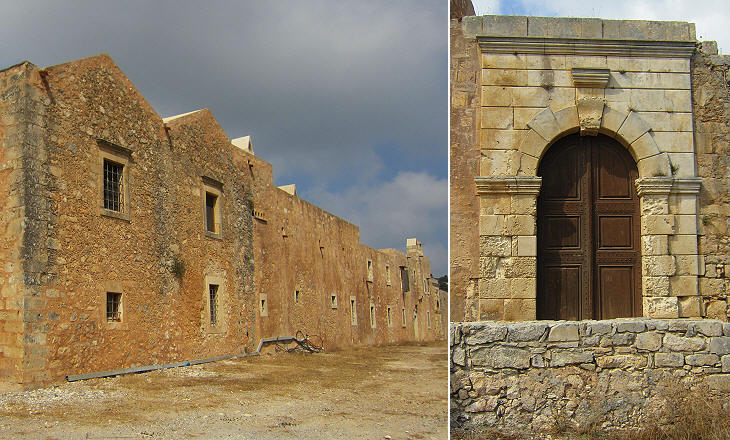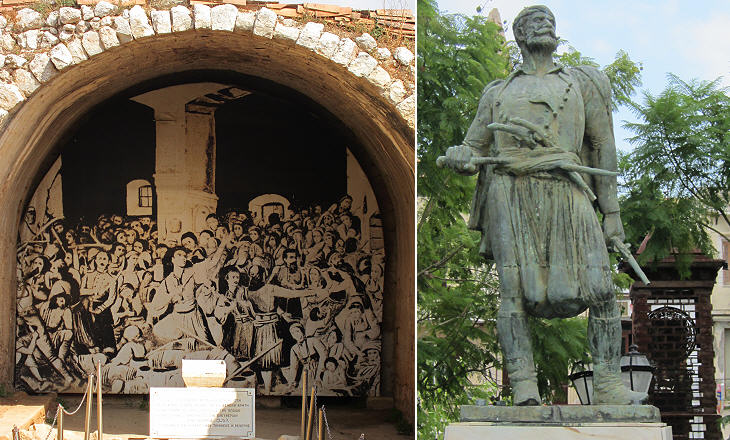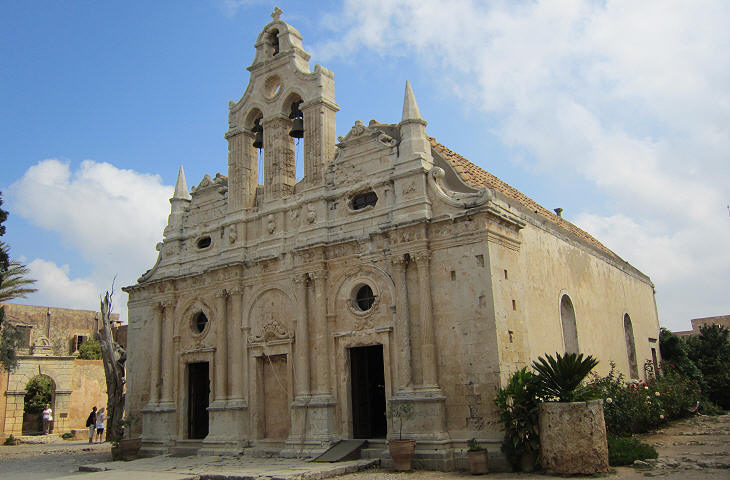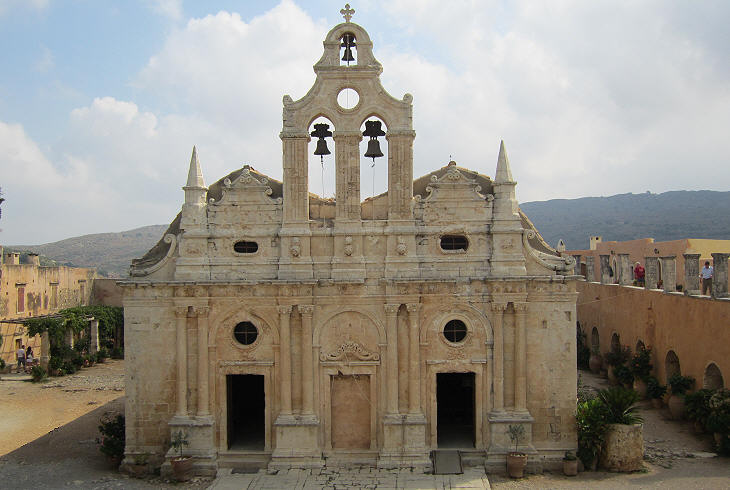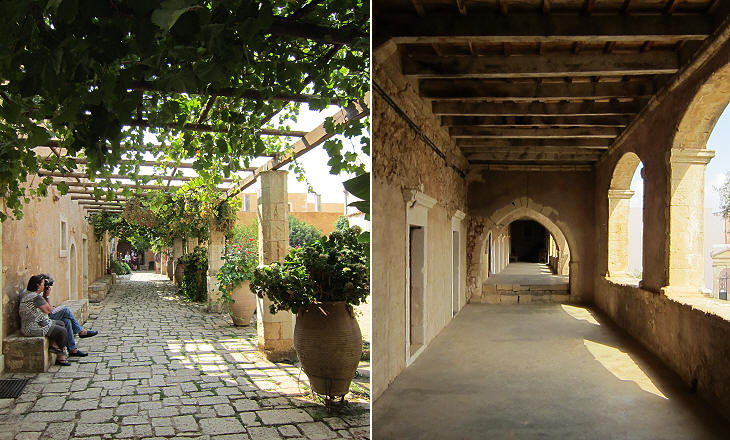  What's New! Detailed Sitemap All images © by Roberto Piperno, owner of the domain. Write to romapip@quipo.it. Text edited by Rosamie Moore. Page revised in February 2012. |
  - An Excursion to Moni Arkadi - An Excursion to Moni Arkadi
On Crete memories of the Venetian past of the island can be found also outside the coastal towns. They mainly date from 1550 to 1650 the last century of Venetian rule, when the Republic implemented policies aimed at gaining, if not the support, at least the non-hostility of its Greek subjects.
Because this page is based on an excursion from Rettimo (Rethymno) it is worth mentioning a tekke, a sort of monastery outside the walls of that town along the road to Moni Arkadi; usually tekke were associated with the brotherhood of the Whirling Dervishes (you may wish to see the mausoleum of the founder of the order at Konya). The building, which currently houses a Natural History Museum, replaced a Catholic monastery dedicated to St. Onuphrius. Because the saint was a hermit, churches or monasteries dedicated to him were usually located out of town (this can be observed also at S. Onofrio in Rome).
Rettimo is known for the portals which were built when the town was reconstructed after having been raided by the Ottomans in 1571. A similar portal can be found in the village of Amnatos, two miles before Moni Arkadi. The inscription is almost identical to that placed by Pope Sixtus V above the entrance to Archiginnasio della Sapienza in Rome: Initium Sapientiae Timor Domini (The Psalms 111, 10 - The fear of the Lord is the beginning of wisdom).
The first image of the monastery is that of a fortified site with all the buildings arranged around a large square courtyard; the white portal which gives access to the interior was built in the late XIXth century after the 1866 events which greatly damaged some parts of the complex.
When in 1821 the Greeks of Peloponnese rose against the Ottomans from Patras and Kalamata, and also the Sfakians, the inhabitants of south-western Crete, who had maintained their Greek Orthodox beliefs, rebelled. Their revolt was quelled by the intervention of Egyptian troops and the whole island was ruled by the Egyptians until 1840. In 1866 Moni Arkadi became the centre of a rebellion of the Rethymno district. Nearly 1,000 people gathered in the monastery, which was soon surrounded by Ottoman troops. Three messengers escaped from the rear door to search in vain for help.
The defenders withstood assaults for two days, but in the end they were unable to prevent the Ottomans from entering through a large breach in the western walls. Women and children sought refuge inside a cellar which had been turned into a powder magazine. When the first Ottoman soldiers were about to enter the building, Kostas Giaboudakis, one of the leaders of the revolt, ignited the barrels of powder causing the death of many soldiers and about all the Greek civilians. In 1898 Crete acquired a semi-independent status and in 1913 it was annexed to Greece. Moni Arkadi became a memorial of the Cretan fight for freedom.
In 1828 J. A. Cramer described Moni Arkadi as the most beautiful and the richest convent of the island, but he was probably relying on second hand information about the economic situation of the monastery which instead was very prosperous in 1587 when a new church was built at the site of a smaller one. At that time the monastery was benefitting from the large revenue deriving from the production of Malvasia di Candia, a sweet wine which was highly praised in western Europe. The name Malvasia derived from the Venetian port by the same name from which a sweet wine of the Peloponnese was shipped. After the Venetians lost Malvasia in the early XVIth century it was applied to other similar wines. The trade of Malvasia di Candia declined during the period of Ottoman rule.
The elaborate fašade of the church was designed by someone familiar with Italian Renaissance developments in the second half of the XVIth century. The fašade does not correspond to the interior of the church which is made up of two identical prayer halls. The walled central door was designed in order to enhance the symmetry of the fašade whereas the central bell tower made it more imposing.
All the main churches of Rethymno were largely modified by the Ottomans after they conquered the town. We can assume that their fašades had an elaborate design, as they were built at the same time as that of Moni Arkadi.
One altar of the church is dedicated to the Transfiguration of Jesus, whereas the other one is dedicated to St. Helena and her son Emperor Constantine, who is revered as a saint by the Greek Orthodox Church. Churches having twin prayer halls where not uncommon in some Venetian possessions such as Nasso; they were built to bring together Catholic and Orthodox subjects.
Introductory page on the Venetian fortresses in Crete Grambusa (Granvousa) and Castello (Kasteli/Kissamos) Candia (Iraklion) La Canea (Xania) and Souda Rettimo (Rethymno) Spinalonga and Castel Mirabello An Excursion to Kritsa Sittia and Paleocastro Castelfranco (Frangokastelo) and other castles on the southern coast Introductory page on the Venetian fortresses You may refresh your knowledge of the history of Venice in the Levant by reading an abstract from the History of Venice by Thomas Salmon, published in 1754. The Italian text is accompanied by an English summary. Clickable Map of the Ionian and Aegean Seas with links to the Venetian fortresses and to other locations (opens in a separate window) |

